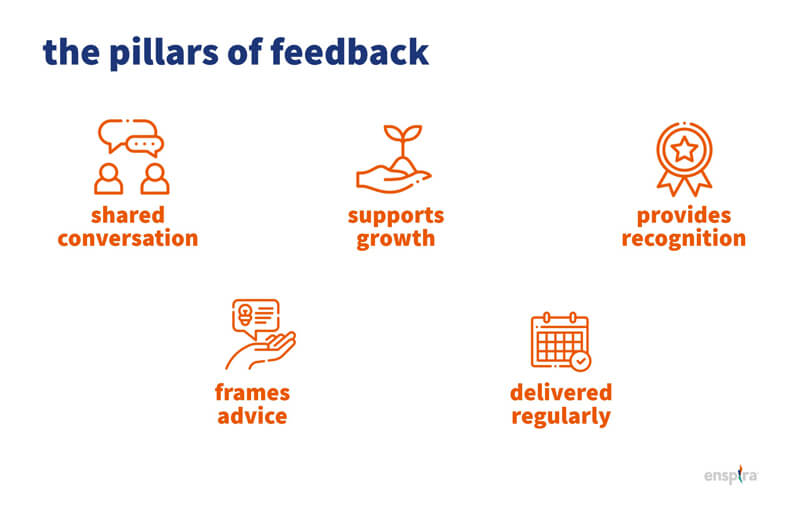Feedback is intrinsic to growth, both in life and in the workplace. It helps us to gauge our performance, correct and learn from our mistakes, identify our strengths and weaknesses, and in essence, develop as people.
But many of us find it difficult to give and receive feedback–which can create ambiguous dilemmas for leaders. Is your feedback too harsh? Is it too vague? How feedback is delivered and received can result in anger, defensiveness, confusion, or a lack of direction.
Simply put, there’s an art to both offering and receiving feedback. Let’s consider some tips that can help establish positive feedback loops.
The Difference Between Feedback and Criticism
Feedback–because its focused on a clear, positive objective–is a far more effective problem-solving tool than criticism, which tends to focus on errors, flaws, or failures. Even with pure intentions, criticism can often be hurtful, and interpreted as an effort by a person who feels superior to another to put someone “in their place.” Constructive feedback, on the other hand, creates a sense of connection between the giver and the recipient.
People who are accustomed to criticism will often resist receiving feedback. It’s the responsibility of leadership to cultivate an environment of mutual respect where feedback-based conversations (vs. critical ones) prevail, and takes time and trust to establish it.
Effective Feedback
One of Enspira’s core offerings is our Manager Essentials Lab (MEL), which defines effective feedback as a shared conversation that supports growth, offers recognition, frames advice, and is delivered regularly. The many benefits of effective feedback include the ability to:
- maximize individual potential
- provide opportunity
- increase self-awareness
- build trust
- improve retention
- enhance performance
- establish goals
- setsand manage expectations
- foster a culture of growth

When providing effective feedback, it’s important to avoid potential pitfalls like speaking in generalities, involving third parties, and bringing personal issues into the conversation. You should also be wary of certain biases that you may bring to the conversation. Some common forms of biases that can seep into your feedback discussions include:
- halo bias: when your overall impression of a person (“she is nice”) impacts your evaluation of that person’s specific traits (“she must also be smart”)
- horns bias: when you make a snap judgment about someone based on a single negative trait (“he showed up late last week, so he must not be a team player”)
Tips For Giving Feedback
When providing feedback, here are some helpful things to keep in mind:
- why are you giving the feedback? what’s your motivation?
- include specific examples
- avoid opinions, particularly of a personal nature, and be aware of potential biases
- make sure you’re familiar with the recipient’s strengths as well as areas they need to work on
- think about questions you can ask before giving the feedback: “How are you finding the new system?” “How have things changed since you started in this position?” “How are you doing?”
- go slowly and carefully listen to the recipient’s responses
- offer feedback regularly
One effective feedback strategy is starting the conversation with a yes-or-no question, which signals the recipient that feedback is coming (i.e., “Do you have a few minutes to discuss some ideas I’d like to share with you?”). It gives the recipient the ability to say yes or no, which helps mitigate fear.

It’s also important to remember that feedback is a process. Be specific about the certain situations in which X behaviors are observed, and discuss the impact those behaviors have on Y. Ask for their take on the situation–and when listening to answers, be prepared to change your position if their responses provide new context.
Finally, express your intention in offering feedback in order to help foster mutual trust and understanding, so challenges can be addressed effectively as a team and working relationships can continue to grow and develop.
Tips for Receiving Feedback
Receiving feedback can be tough, particularly if similar past experiences have been demeaning or unhelpful. Keep in mind that many managers struggle to give effective feedback. Be patient, and recognize that in most cases, it’s not personal.
However, if you’re someone who tends to take things personally, try to process it as new and helpful information, like you would the weather report: It may change what you do tomorrow morning, but it’s not personal. This tactic helps remove emotion from the discussion so you can better focus on the overall message.
Important things to remember while receiving feedback:
- be appreciative
- understand the purpose
- assume the best intentions
- focus on improvement
- listen carefully
- be open-minded
- ask questions
- pause and reflect
- don’t take it personally
If you tend to tense up during feedback conversations, remember to breathe. Simple actions like relaxing your shoulders and hands can help put your mind at ease.
Effective feedback is a gift. Project an attitude of gratitude. The person giving the feedback may also be feeling tense or nervous, particularly if they’re new to the process, so a simple “thank you” often goes a long way.
If the feedback is vague or confusing, ask for specifics. Feedback conversations are two-way discussions. Ask questions to clarify what’s been said and demonstrate that you were listening. You might start by saying, “I want to make sure I heard you correctly and that we’re on the same page…”
Asking for Feedback
A recent Gallup poll found that only 17% of millennials receive meaningful, frequent feedback at work. They’re not alone: more and more employees are realizing the value of feedback, and recognizing that receiving it once a year during an annual review is insufficient.
So take the initiative and ask for feedback. It can be specific: “How did my response in the meeting serve to share our team’s values??” Or more general: “Where do you see I have opportunities for growth ?” If you’re the leader giving the feedback, ask for feedback on your feedback.
Feedback conversations don’t always feel natural–but with regular practice and implementation strategies, they can strengthen your working relationships and make them decidedly more productive.



